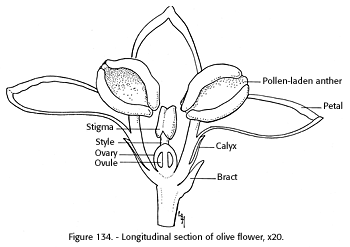OLIVE
Olea europaea L., family OleaceaeThe olive is grown commercially in California on about 27,000 acres where 52,000 tons, valued at $12.8 million, were produced in 1970. In addition, in 1970, we imported 16.3 million gallons of olives in brine and 64 million pounds of edible olive oil.
Plant:
The olive tree is usually 15 to 20 feet tall, but sometimes reaches 30 to 35 feet when fully developed and properly nurtured, with oval 1- to 3-inch gray-green leaves and gray branches. Its beauty, sturdiness, and symmetrical growth make it a prized ornamental as well as a commercial fruit tree. It will live hundreds of years in mild, arid climates. It blossoms profusely in the spring, producing the well-known oval, one- seeded, green to blue-black fruit about an inch long. It is cultivated somewhat like other warm-weather fruit or nut trees. In the grove, the trees are spaced well apart (35 to 40 feet) so the sunlight can reach the tree on all sides.
Inflorescence:
The cluster of one to two dozen, 4 mm, cream-colored to white fragrant flowers that develops in the axil of the leaf is usually shorter than the leaf itself. The individual flower has four valvate corolla lobes, a short four-toothed calyx, and two stamens that produce pollen copiously and little, if any, nectar (fig. 134). The flower opens before pollen is released from the anthers so cross-pollination can occur before selfing with the flower is possible. The flower may be either perfect and potentially fruitful with a plump green pistil, short style, and green ovary; or only staminate with a yellow abortive pistil (Condit 1947). No purely pistillate flowers occur. Most cultivars are self-fertile, but some are self-sterile, and others are intermediate (Crider 1922, Morettini 1957, Mort 1952, Pierce 1896). Occasionally, a poor fruit crop results from a flowering of almost entirely staminate flowers (Hartmann and Opitz 1966).
Honey bees collect pollen rather sparingly from the olive even though it is present in great abundance at flowering time. Sometimes, an olive honey flow is reported by beekeepers, but Silvestri et al. (1947) and Pellett (1949*) believed that the food source was honey dew from aphids on the olive and not nectar from the blossoms.
[gfx] FIGURE 134. - Longitudinal section of olive flower, x 20.

Pollination Requirements:
The pollination requirements of different cultivars of olives vary considerably. Crider (1922) listed two self-sterile, one partly self- sterile, and five self-fertile cultivars. Bradley et al. (1961) showed in greenhouse studies that even in self-pollinating cultivars, the pollen tubes of other cultivars grew down the style faster than self pollen tubes under the same temperature conditions. They found that if pollen tube growth was too slow, the embryo sac began to degenerate before the tube reached it; therefore, no fertilization would result. They concluded that "the chances of fertilization were greater in cross- than in self- pollinations, as indicated by the higher percentages of pistils in which a pollen tube reached the embryo sac."
Hartmann and Opitz (1966) stated that most varieties examined in Italy were self-sterile, a few were self-fertile, and some were partially self-fertile. They also stated that both in Portugal and in California satisfactory crops are obtained when some cultivars are planted in solid blocks although highest and most consistent yields are obtained in orchards where two cultivars are interplanted. This, they said, reaffirmed former studies at Davis and Winters, Calif., that cross-pollination of some varieties will increase fruit set in some years.
Pollinators:
Wind is considered the primary agent in the transfer of olive pollen. Honey bees visit the trees for pollen, and the general knowledge of bee activity on other plants would indicate that if they moved freely from plant to plant they would effectively transfer some pollen between varieties. Should insignificant wind movement - in the proper direction - occur during flowering so that it would fail to transfer the pollen adequately then the activity of honey bees could supplement wind activity.
Honey bees do not collect olive pollen as avidly as they do that of other plants. To create heavy olive flower visitation, might require a relatively heavy concentration of honey bee colonies in or near the grove. There is no information on the concentration that might be desired. Studies in this area would be productive.
Pollination Recommendations and Practices:
None.
LITERATURE CITED:
BRADLEY, M. V., GRIGGS, W. H., and HARTMANN, H. T.
1961. STUDIES ON SELF- AND CROSS-POLLINATION OF OLIVES UNDER VARYING TEMPERATURE CONDITIONS. Calif. Agr. 15(3): 4-5.CONDIT. I. J.
1947. OLIVE CULTURE IN CALIFORNIA. Calif. Agr. Ext. Serv. Cir. 135,36 PP.CRIDER, F. J.
1922. THE OLIVE IN ARIZONA. Ariz. Agr. Expt. Sta. Bul. 94: 491-528.HARTMANN, H. T., and OPITZ, K. W.
1966. OLIVE PRODUCTION IN CALIFORNIA. Calif. Agr. Expt. Sta. and Ext. Serv. Cir. 540,63 PP.MORETTINI, A.
1958. [THE BIOLOGY OF FERTILIZATION IN OLIVE CULTIVARS AND ITS PRACTICAL IMPORTANCE.] Italian. Agr. 94: 1103-1116. [In Italian. ] Plant Breed. Abstracts 28(3): 586587.MORT, C. H.
1952. FRUITFULNESS IN OLIVES. Agr. Gaz. N.S. Wales 63: 371-372.PIERCE, N. B.
1896. OLIVE CULTURE IN THE UNITED STATES. U.S. Dept. Agr. Yearbook 1896: 371-390.SILVESTRI, F., MORETTINI, A., and ZAPPI-RECORDATI, A.
1947. [THE BEE AS A POLLINATOR OF THE OLIVE.] Olivicoltura 2(9): 12-15. [In Italian.]
